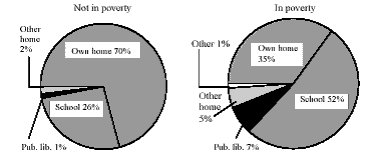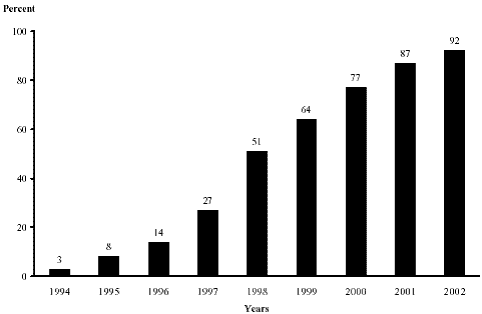Internet Access Locations
Computers and the Internet recently passed a milestone: both are now used by a majority of Americans. Two-thirds of Americans used computers in 2001, up from about one-half in 1997, and 54 percent used the Internet, up from about a third in 1997. Currently, the use of these technologies is more widespread among children and adolescents ages 5 through 17 than among adults: about 90 percent of 5- to 17-year-olds use computers and 59 percent use the Internet.
Figure 1 looks at children and adolescents who access the Internet through one location only. Such youth make up approximately 39 percent of all 5- through 17-year-olds who use the Internet and number approximately 12.2 million. Looking at the data in this way helps to more clearly illustrate the role schools play in providing Internet access for children and adolescents by showing how heavily students from some backgrounds rely on schools for access. The figure shows that the home is the most likely point of access among those who access the Internet from only one location. Nearly two-thirds of these Internet users rely solely on home access.
However, several groups-those from households where no parents have a high school credential, those from monolingual Spanish households, and those in poverty-rely more heavily on access to the Internet from school than from any other single location. Fifty-nine percent of children and adolescents who have parents who have not earned a high school credential and who have only one point of access for the Internet rely on school facilities for this access.
Conversely, 16 percent of children and adolescents living with parents who attended graduate school and who use the Internet in only one place do so through school facilities. Fifty-eight percent of users with one point of access who belong to Spanish-monolingual households rely solely on school for access, compared to 30 percent of users with one access point who belong to other households, and about half of poor users with one access point do so, compared to about a quarter of non-poor users with only one access point (figure 1). Without access at school, these users would be forced to find alternative points of access or would cease using the Internet.
Figure 1.?Percentage of children and adolescents age 5-17 who use the Internet at only one location, by location and poverty status: 2001

NOTE: Estimates may not sum to 100 percent because of rounding.
SOURCE: Figure 5 in U.S. Department of Education. National Center for Education Statistics. Computer and Internet Use by Children and Adolescents in 2001 Statistical Analysis Report, NCES 2003-014, by Matthew DeBell and Chris Chapman. Washington, DC: 2003.
Public schools have made consistent progress in expanding Internet access in instructional rooms1, from 3 percent in 1994 to 77 percent in 2000 and 92 percent in 2002 (figure 2). In 2002, there were differences in Internet access in instructional rooms by locale. A smaller percentage of instructional rooms were connected to the Internet in city schools (88 percent) than in schools located in towns (96 percent) and rural areas (93 percent).
NOTE: Percentages are based on all schools. All of the estimates in this report were recalculated from raw data files using the same computational algorithms. Consequently, some estimates presented here may differ trivially (i.e., 1 percent) from results published prior to 2001.
SOURCE: Figure 1 in U.S. Department of Education. National Center for Education Statistics. Internet Access in U.S. Public Schools and Classrooms: 1994-2002 , NCES 2003-4011, by Anne Kleiner and Laurie Lewis. Washington, DC: 2003.
_____________________1 Instructional rooms include classrooms, computer and other labs, library/media centers, and any other rooms used for instructional purposes.
